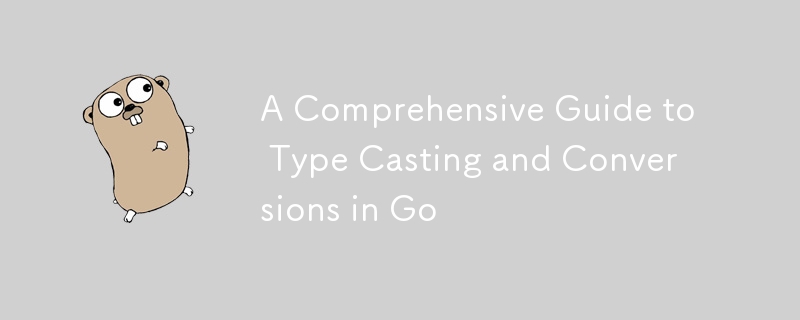Home >Backend Development >Golang >A Comprehensive Guide to Type Casting and Conversions in Go
A Comprehensive Guide to Type Casting and Conversions in Go
- 王林Original
- 2024-08-20 07:00:31603browse

Go, also known as Golang, is a statically typed language. This means that the type of every variable is known at compile time, providing safety and predictability in your code. However, this also requires that any conversion from one type to another is explicit and deliberate. In this article, we’ll explore the various type casting and conversion mechanisms available in Go, from basic numeric conversions to more complex interface and pointer conversions.
1. Basic Type Conversions
Go allows conversion between basic types like integers, floating-point numbers, and strings, but these conversions must be done explicitly.
Numeric Types
Conversions between different numeric types are straightforward but must be explicit:
var i int = 42 var f float64 = float64(i) // int to float64 var u uint = uint(i) // int to uint
In this example, we convert an int to a float64 and to a uint. These conversions are explicit because Go does not perform automatic (implicit) type conversions.
String and Byte Slice
Go strings are immutable, but they can be converted to and from byte slices ([]byte), which are mutable:
var s string = "hello" var b []byte = []byte(s) // string to []byte var s2 string = string(b) // []byte to string
Similarly, you can convert between strings and rune slices ([]rune), where rune is a type alias for int32:
var r []rune = []rune(s) // string to []rune var s3 string = string(r) // []rune to string
2. Custom Type Conversions
In Go, you can define your own types based on existing ones. Conversions between custom types and their underlying types are explicit:
type MyInt int var i int = 10 var mi MyInt = MyInt(i) // int to MyInt var i2 int = int(mi) // MyInt to int
This explicit conversion is necessary to ensure that the compiler can verify the safety of your code.
3. Pointer Conversions
Pointers in Go reference the memory address of a variable. You can convert between a value and its pointer:
var x int = 42 var p *int = &x // int to *int (pointer to int) var y int = *p // *int to int (dereferencing)
4. Interface Type Conversions
Interfaces in Go are used to define a set of methods. You can convert between concrete types and interfaces:
var a interface{} = 42 // int to interface{}
var b int = a.(int) // interface{} to int (type assertion)
Type Assertions
A type assertion provides access to an interface's concrete value:
if v, ok := a.(int); ok {
fmt.Println("a is an int:", v)
}
Type Switch
A type switch allows you to perform different actions based on the dynamic type of an interface:
switch v := a.(type) {
case int:
fmt.Println("a is an int:", v)
case string:
fmt.Println("a is a string:", v)
default:
fmt.Println("a is of unknown type")
}
5. Unsafe Conversions
The unsafe package allows you to bypass Go’s type safety, enabling conversions that would otherwise be illegal:
import "unsafe" var i int = 42 var p *int = &i var fp *float64 = (*float64)(unsafe.Pointer(p)) // *int to *float64
Warning: Unsafe conversions should be used sparingly and only when absolutely necessary, as they can lead to undefined behavior.
6. Channel Type Conversions
Channels are a powerful feature in Go, allowing communication between goroutines. You can convert between bidirectional and unidirectional channels:
ch := make(chan int) var sendOnlyChan chan<- int = ch // bidirectional to send-only var recvOnlyChan <-chan int = ch // bidirectional to receive-only
7. Struct and Array Conversions
Conversions between structs or arrays with identical layouts require explicit casting:
type Point struct {
X, Y int
}
type Coord struct {
X, Y int
}
var p Point = Point{1, 2}
var c Coord = Coord(p) // Convert Point to Coord (same field types)
8. Slice Conversions
Slices are references to arrays, and while you can convert between slices of the same type, converting between different types of slices requires an explicit conversion:
var a []int = []int{1, 2, 3}
var b []int = a[1:] // Convert a slice to another slice of the same type
9. Nil Interface Conversions
A nil value in Go can be assigned to any interface type:
var x interface{} = nil
var y error = nil
10. Function Type Conversions
Go functions can be converted to different types, provided the signatures are compatible:
type FuncType func(int) int
func square(x int) int {
return x * x
}
var f FuncType = FuncType(square) // Convert function to FuncType
11. Array-to-Slice Conversion
You can create a slice from an array, which is essentially a reference to the array:
var arr [5]int = [5]int{1, 2, 3, 4, 5}
var sl []int = arr[:] // Convert array to slice
Conclusion
Type casting and conversions in Go are explicit by design, making the code safer and easier to understand. By requiring explicit conversions, Go helps prevent subtle bugs that can arise from implicit type coercion, common in some other programming languages. Understanding these conversions and using them correctly is crucial for writing robust and efficient Go programs.
The above is the detailed content of A Comprehensive Guide to Type Casting and Conversions in Go. For more information, please follow other related articles on the PHP Chinese website!
Related articles
See more- How Can I Customize the Appearance of Individual GUI Components in Fyne?
- How to Efficiently Get a Specific Time for the Following Day in Go?
- How Do I Convert Weekday Strings to time.Weekday in Go Efficiently?
- Why does `sync.Once` utilize atomic operations like `atomic.StoreUint32` instead of a simple assignment?
- How to Send Private Messages to Specific Clients in Go with Gorilla Websocket?

